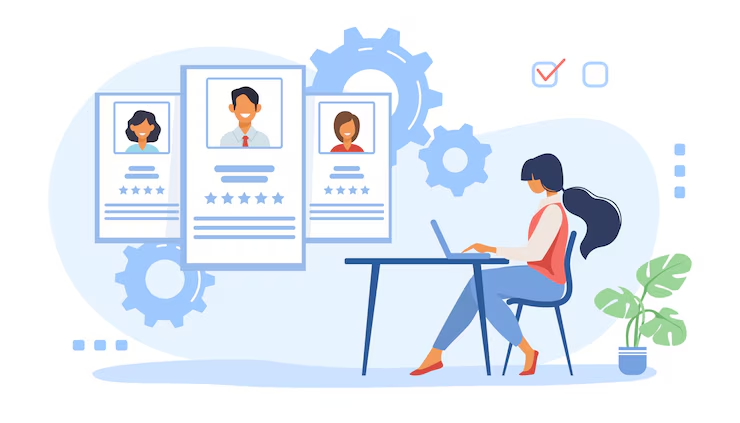Effective human resource management extends beyond mere timekeeping, payroll processing, and record-keeping. Businesses aiming for sustainable growth require a deeper, more strategic approach to building a robust workforce. However, many organizations still grapple with fragmented processes, disconnected data, and a lack of supportive tools. This leads to an increasing administrative burden, while simultaneously diminishing employee experience and hindering leadership's decision-making capabilities.
Enterprise Resource Planning (ERP) software offers a comprehensive solution to this challenge. By integrating data and automating workflows, ERP enables businesses to boost productivity, minimize errors, and optimize human resource management.
In this article, we will explore the role of ERP in HR management, its key benefits, and effective application strategies for developing talent and driving sustainable business growth.
2. Common challenges in traditional HR management

In many businesses, the HR department still operates using manual methods or disparate systems. This leads to a range of difficulties that directly impact management efficiency and employee experience. Below are some common challenges:
Fragmented HR information, difficult to access and consolidate
HR data is often stored across multiple Excel files, emails, or separate software, making it difficult to look up, update, and synchronize information in a timely manner.
Time-Consuming, error-Prone, and redundant manual processes
From timekeeping and payroll to records management, manual processing can easily lead to data entry errors, wasted time, and inconvenience for both employees and the HR department.
Difficulty in tracking employee performance and development
A lack of supporting tools makes it challenging to objectively evaluate job performance, recognize achievements, or create training plans based on clear data.
Limited data analysis capabilities and decision support
Disparate HR data makes it difficult for leadership to analyze trends, forecast staffing needs, or make strategic decisions regarding recruitment, retention, and team development.
Challenges in ensuring compliance with laws and internal policies
Managing HR through manual methods increases the risk of non-compliance with regulations regarding insurance, taxes, labor contracts, etc., leading to potential legal risks and damage to the company's reputation.
3. Superior benefits of ERP Software in Human Resources Management

Implementing ERP software in HR management delivers significant practical value, not only streamlining processes but also enhancing management quality and employee experience. Key benefits include:
Centralized HR data:
ERP facilitates the storage of all HR information (employee records, contracts, compensation, training, performance reviews, etc.) on a single, easily accessible, updatable, and manageable platform. This eliminates data silos and inconsistencies.
HR process automation:
Repetitive tasks such as timekeeping, payroll processing, leave management, and contract renewal reminders are fully automated, saving time, reducing errors, and increasing transparency.
Optimized HR department efficiency:
ERP software supports the standardization of processes and minimizes manual paperwork, allowing the HR department to focus on strategic initiatives like training, talent development, and fostering company culture.
Improved analysis and reporting:
ERP provides powerful analytical tools and intuitive reports for tracking HR trends, work performance, attrition rates, etc., thereby empowering managers to make data-driven decisions.
Enhanced employee experience and satisfaction:
Through a self-service portal, employees can easily manage their personal information, view payslips, apply for leave, and submit related requests – thus increasing proactivity and job satisfaction.
Ensured legal compliance:
ERP helps businesses track and update labor regulations, tax laws, social insurance requirements, etc., ensuring HR operations consistently align with legal frameworks and mitigating legal risks.
Support for strategic decision-making:
With a holistic view and real-time updated data, managers can readily assess current resources and plan recruitment, training, and team development in line with the company's long-term objectives.
3. Key HR management modules in ERP software

Employee master data management:
- Stores and manages comprehensive employee information (personal details, contracts, work history, etc.).
- Ensures data consistency and accuracy.
Recruitment:
- Manages the entire recruitment process, from job posting and candidate screening to interviews and hiring decisions.
- Optimizes recruitment time and costs.
Time & attendance management:
- Tracks employee working hours, leave days, and overtime.
- Automates payroll calculations and time-related compensation schemes.
Payroll & benefits management:
- Automates the payroll process, including taxes, insurance, and other benefits.
- Ensures accuracy and compliance with regulations.
Performance management:
- Sets objectives, tracks, and evaluates employee performance.
- Supports feedback and employee development processes.
Learning & development:
- Plans training initiatives and manages courses and training programs.
- Monitors training progress and effectiveness.
Absence management:
- Manages various types of leave, sick leave, and other forms of absence.
- Ensures transparency and adherence to company policy.
Employee self-service (ESS):
- Provides a portal for employees to self-manage personal information, view payslips, apply for leave, etc.
- Reduces workload for the HR department
4. Selecting and implementing ERP software for effective HR management

Identify specific business needs and objectives
- Define the company's specific requirements and goals.
- Assess the current state of HR management: recruitment processes, timekeeping, payroll, performance evaluation, etc.
- Set specific objectives: increase management efficiency, improve employee experience, enhance HR data transparency, integrate with other departments like finance and accounting.
Research and compare ERP software providers
- Explore popular ERP solutions such as: Odoo, Sota HRM, etc.
- Compare based on criteria such as: HR management features, cost, customization capabilities, technical support, integration capabilities, user interface.
- Seek feedback from current users, expert opinions, and industry articles.
Select the ERP software suitable for the company's scale and specifics
- For SMEs: consider cost-effective and easy-to-implement solutions.
- For large enterprises: prioritize robust integrated ERP systems with scalability and multinational support like SAP, Oracle, Odoo.
- Consider specific requirements such as industry (manufacturing, services, technology, etc.), flexible or geographically dispersed workforce models.
Develop a detailed implementation plan
- Define the scope of implementation (by department, by feature, by phase).
- Establish an implementation project team: including representatives from HR, IT, finance, etc.
- Develop a specific roadmap: data preparation – installation – training – testing – go-live.
User training
- Organize training sessions for HR staff and relevant department managers.
- Prepare user manuals and new internal procedures.
- Establish a responsive support channel during the initial usage phase.
Data migration
- Standardize and cleanse existing HR data (personal information, contracts, compensation, etc.).
- Migrate data from the old system to the new ERP software, ensuring accuracy and security.
Testing and adjustment
- Conduct thorough testing of all functions: timekeeping, payroll, reporting, recruitment management, etc.
- Collect user feedback to adjust the system to align with actual operations.
Post-implementation support and maintenance
- Maintain a technical support team during the initial post-implementation phase.
- Monitor system performance and update software regularly.
- Re-evaluate after 3-6 months to optimize processes and features based on new needs.
5. Conclusion
Human Resources management has evolved beyond a mere administrative function to become a strategic pillar in the growth and development of every enterprise. The implementation of ERP software not only digitizes the entire HR process but also unlocks a more modern, transparent, and efficient approach to managing human capital – the most valuable asset of any organization.
A suitable ERP system can transform disparate data into a holistic overview, convert manual processes into automation, and shift decisions based on intuition to actions driven by precise analysis. However, to achieve this, businesses need a systematic approach – from defining objectives and selecting the right software to deployment, training, and ensuring effective ongoing operation.
Investing in ERP for HR management is not simply a technology choice, but rather the adoption of a new management mindset – one that is smarter, more agile, and future-ready. Contact us for consultation and receive complimentary materials on the latest technology trends.